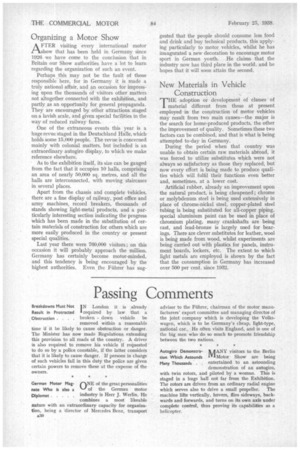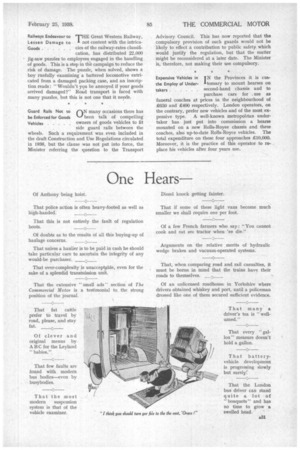Passing Comments
Page 32

Page 33

If you've noticed an error in this article please click here to report it so we can fix it.
Breakdowns Must Not IN London it is already Result in Protracted A required by law that a
Obstruction . . . broken down vehicle be removed within a reasonable tune if it be likely to cause obstruction or danger. The Minister has now made Regulations extending this provision to all roads of the country. A driver is also required to remove his vehicle if requested to do so by a police constable, if the latter considers that it is likely to cause danger. If persons in charge of such vehicles fail in this duty the police are given certain powers to remove these at the expense of the owners.
German Motor MagriNE of the great personalities nate Who is also a ‘,-, of the German motor Diplomat industry is Herr J. Weriin. He combines a most likeable nature with an extraordinary capacity for organization, being a director of Mercedes Benz, transport a3o adviser to the Fiihrer, chairman of the motor manufacturers' export committee and managing director of the joint company which is developing the Volkswagen, which is to be Germany's cheap, light-type, national car., He often visits England, and is one of the big men who do so much to promote friendship between the two nations.
Autogiro DemonstraAANY visitors to the Berlin
tion Which Astounds I VIMotor Show are being Many Thousands . . entertained to an astounding
demonstration of an autogiro, with twin rotors, and .piloted by a woman. This is staged in a huge hall not far from the Exhibition. The rotors are driven from an ordinary radial engine which serves also to drive a small propeller. The machine lifts vertically, hovers, flies sideways, backwards and forwards, and turns on its own axis under complete control, thus proving its capabilities as a helicopter.
Railways Endeavour to 9'I{E Great Western Railway, Lessen Damage to I not content with the intrica Goods cies of the railway-rates classifi cation, has distributed 22,000 jig-saw puzzles to employees engaged in the handling of goods. This is a step in the campaign to reduce the risk of damage. The puzzle, when solved, shows a boy ruefully examining a battered locomotive extricated from a damaged packing case, and an inscription reads : " Wouldn't you be annoyed if your goods arrived damaged?" Road transport is faced with many puzzles, but this is not one that it needs.
Guard Rails Not to rIN many occasions there has be Enforced for Goods '—'been talk of compelling
Vehicles owners of goods vehicles to fit side guard rails between the wheels. Such a requirement was even included in the draft Construction and Use Regulations circulated in 1936, but the clause was not put into force, the Minister referring the question to the Transport Advisory Council. This has now reported that the compulsory provision of such guards would not be likely to effect a contribution to public safety which would justify the regulation, but that the matter might be reconsidered at a later date. The Minister is, therefore, not making their use compulsory.
Expensive Vehicles in TN the Provinces it is cmthe Employ of UnderItomary to mount hearses on
takers . . . . . second-hand chassis and to purchase cars for . use as funeral coaches at prices in the neighbourhood of £650 and 2400 respectively. London operators, on the contrary, prefer new vehicles and of the most expensive type. A well-known metropolitan undertaker has just put into commission a hearse mounted on a new Rolls-Royce chassis and three coaches, also up-to-date Rolls-Royce vehicles. The total expenditure on these four approaches £10,00Q. Moreover, it is the practice of this operator to replace his vehicles alter four years use
































































































